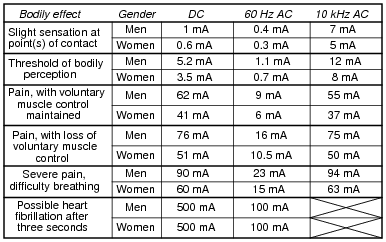yea i got it now it cus system used in us isn't TT , but reducing touching voltage by reducing R fault is important to reduce degree of the shock specially in TT cus R is much higher ..
Still Have question in TC or tcs
View attachment 15652
Reducing R will reduce the voltage relative to remote earth, however even if soil R equaled zero, you would still have some voltage to remote earth because the earthing wires have impedance themselves. What matters in any case to the protection of people is the speed at which the supply is disconnected during a fault. IEC 1200-413 Technical Report is a great resource in understanding this. I will post the graph which demonstrates voltage vs time in relation to protecting people.
in this system I wanna ask about the touching voltage at normal operation for single phase load
where the metallic body of the equipment is connected to neutral which carry the load current in this case ..is there any voltage between the equipment and the earth in this normal operation case ..
Yes, there is and always will be voltage between the case and remote earth / other earthed objects in TN-C. This is due to the impedance of the PEN conductor. The more impedance in the PEN conductor the higher the case voltage for any given current flowing.
or due to the very small impedance of the return path from neutral to the grounding supply the voltage will be safe value ? so it depending on the neutral resistance ?
Well, thats highly relative. In most wiring practices the case to earth voltage is small, about a few volts. However, depending on the situation those few volts may be either benign or detrimental. Take gas pumps in the Untied States. The NEC mandates that the neutral conductor be broken when the hot conductor is opened. Why? Because the few volts on the neutral conductor is enough to cause a very small spark to ignite flammable vapors. In Hospitals, where people are undergoing procedures and connected to equipment like EKGs, those few volts going 24/7 can cause great harm to the individual whose body resistance is significantly lowered.
the question is connecting the body to the neutral during normal operation is a safe procedure ?
Well, for something like a home, it is usually safe, but not considered reasonably safe. Those few volts might not harm anyone under normal indoor use of a product, but should the PEN conductor break the case will be live at either 120 or 230 volts relative to earth and everything else. As a result, instead of the appliance simply not working, it becomes a lethal hazard.
In the US, ranges and clothes dryers not used in mobile homes were allowed to connect the metal case to the neutral wire up until 1996. However, after 1996 that changed requiring a separate ground (PE) wire.
and related your answer guys above i got that the effective protective device is what is important ..this meaning it would trip even before i feel any pain during direct/indirect contact ?
Hard to say if you will feel anything or what as I don't know much about the human body and stimulus response, but, its considered the faster an OCPD/RCD/GFCI operates the better.
if so that's why I shocked when I touched neutral line in single phase load ? may be the voltage was much lower than the supply voltage but still unsafe ..and may be the protective device wasn't effective due to setting or bad choice - it was OCD in TT system it had to be RCD ..?
RCDs and GFCI do not protect against electric shock, they protect against electrocution and serious burns. It is still possible to feel a painful shock if say 10ma is passing through your body but its not enough to exceed the 30ma threshold of an RCD. Same can happen with a GFCI, if only 2ma is passing through you it might not trip, but you will still feel something. The idea is that because its not over 5ma, the person can still "let go".
In terms of voltage, if a person's resistance is low enough, a supply as low as 12 volt can pass enough current to hurt. In fact in cases of swimming pools its been documented where just a few volts can result in painful shock.




